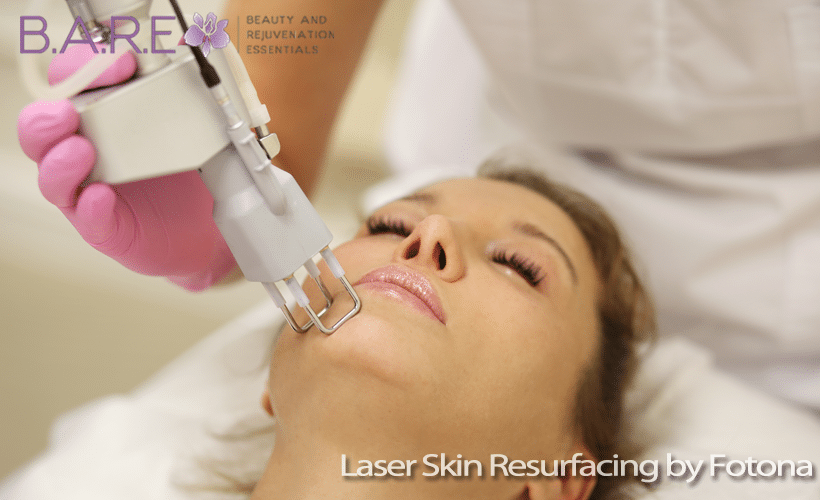
Skin problems can sometimes be stubborn – especially signs of aging, acne scars, sun damage, and more. But the cosmetic treatment industry has come a long way. And one key weapon to combat skin problems now is esthetic beauty equipment, with laser skin resurfacing being among the most popular facial treatment options.
Laser skin resurfacing is a treatment option that uses a laser to improve skin texture and appearance. Whether it’s sun spots, age spots, wrinkles, rosacea, scars, liver spots, birthmarks or anything else, our skin resurfacing treatment can help get rid of these problems. And since it’s not an invasive surgical procedure, you’ll recover quickly as it also promotes collagen growth.
So let’s take a look at the details of this innovative new laser resurfacing treatments from Fotona Dynamis and whether it is the ideal option for you.
What is Laser Skin Resurfacing Treatment?
Laser skin resurfacing is a cosmetic procedure that uses laser beams to improve the layers of skin. It helps eliminate conditions like blemishes, wrinkles, uneven skin tone, or skin color etc., caused by age, sun exposure, medical conditions, and more. Our trained spa technicians can give you a free consultation and perform the skin care procedure here at our Tecumseh Spa.
Types of Laser Skin Resurfacing Treatments – and How They Work
Laser skin resurfacing treatments can be broadly divided into two types – ablative and non-ablative. These are implemented depending on individual needs and skin conditions.
Ablative Laser Resurfacing –
Ablative laser resurfacing is a process in which laser beams vaporize and remove the outer skin layer called the epidermis. It also heats the underlying layer called the dermis to stimulate collagen production. As a result, you get firm, smooth, and even-toned skin.
Types of laser resurfacing include –
- CO2 – It is used for scars, deep wrinkles, warts, enlarged pores, etc.
- Erbium laser – It can treat moderately deep wrinkles, fine lines, and other superficial skin problems.
- Fractional laser – It is helpful in eliminating acne scars, hyperpigmentation, and wrinkles.
Non-Ablative Laser Resurfacing –
Non-ablative resurfacing treatment options are milder as they do not remove the epidermis. However, they boost collagen production to improve your skin, though the results are more subtle. However, it takes much less post-procedure care, and many people prefer it because they don’t have to deal with peeling.
Types of laser resurfacing include –
- Neodymium Yag – It removes birthmarks, hyperpigmentation, and inflammatory acne.
- Pulse-dye laser – It is effective in blood vessel-related issues like rosacea and broken capillaries.
- Fractionated laser – It can also be non-ablative, treating signs of aging, uneven skin tone, etc.
- Intense pulsed light – This light-based treatment repairs scars, stretch marks, sunburn, etc.
How to Prepare for Laser Skin Resurfacing
You can’t just walk into your nearest dermatologist’s clinic or health facilities for a laser skin resurfacing treatment. You need some preparation first.
- Consult a dermatologist and present your history of medical conditions, recent surgical procedures or skin treatments like dermal fillers, etc., to see if you’re the ideal candidate.
- Use broad-spectrum sunscreen every day and avoid sun exposure for at least four weeks before undergoing the treatment.
- Avoid using deep peel treatments like chemical peels, dermabrasion, and other options for at least four weeks before the procedure.
- Stay away from medications like doxycycline, minocycline, etc., which cause photosensitivity for at least four days before the procedure.
- If you have a history of skin conditions like cold sores, you may have to take antiviral medicines for 2-3 days.
- You may need to use a topical retinoid on the skin for around 4 weeks.
What to Expect from Laser Skin Resurfacing Procedure
Before the actual treatment, your doctor may perform a series of treatments for a few weeks. This helps improve your skin’s tolerance level and decrease the chances of side effects.
- During the main procedure, your doctor will start by applying topical anesthesia to the area of treatment. It will reduce your pain when laser beams are applied. You may need sedatives.
- After that, the skin in the treatment area will be cleaned to remove dirt, dead skin cells, oil, bacteria, etc., from the site to prevent infections or other complications.
- Then, using a state-of-the-art Fotona laser device, laser or light beams will be applied to the area. It is a handheld device that needs to be moved around the area.
- Since it is a non-surgical procedure, the session should take 30-120 min. Factors like the area of treatment and laser type will affect the time limit of each session.
- After the session, the area will be dressed in wraps to protect it for the next 24 hours. This will protect the area from infections and other issues.
Post Procedure Care
You can remove the wrap from the treated area after 24 hours. Then, you must follow some basic instructions.
- You may have to clean the treated area 3-5 times a day. Make sure to use only the cleansing solution that your doctor prescribes.
- You’ll have to apply some moisturizing agent on the treated area to prevent dryness and scab formation during the healing process.
- If your natural skin colour is dark, you may need to use a bleach-based product to prevent hyper-pigmentation during and after healing.
The good news is you don’t need to dedicate time and energy to long-term care after the treatment as the recovery time is very short.
Contact BARE Essentials Spa
BARE Essentials Spa takes pride as the best place for laser skin resurfacing in Tecumseh, Ontario. We have a team of experts with experience performing customized treatments to cater to individual needs.
Get started with healthier skin and contact us today to get a youthful, blemish-free glow on your face and skin!

